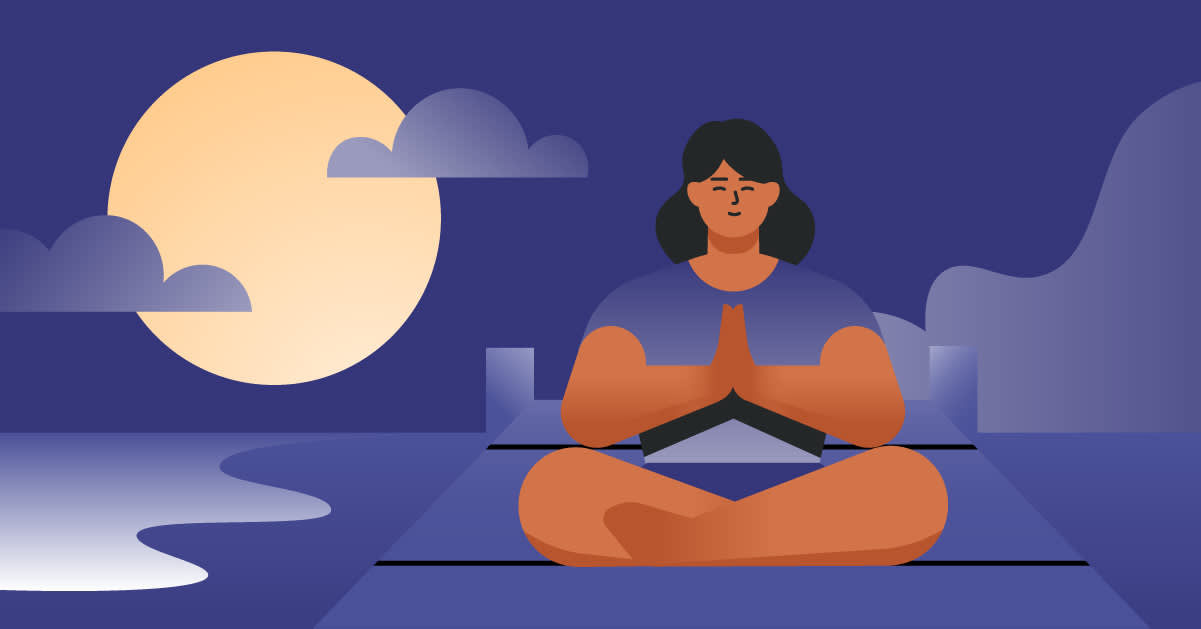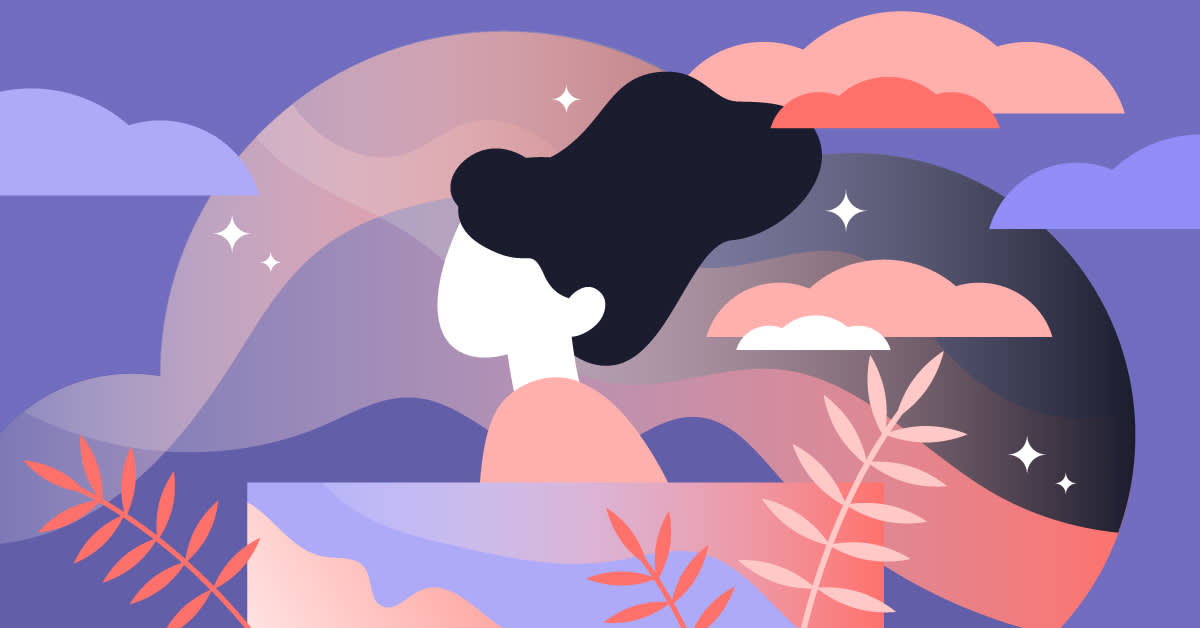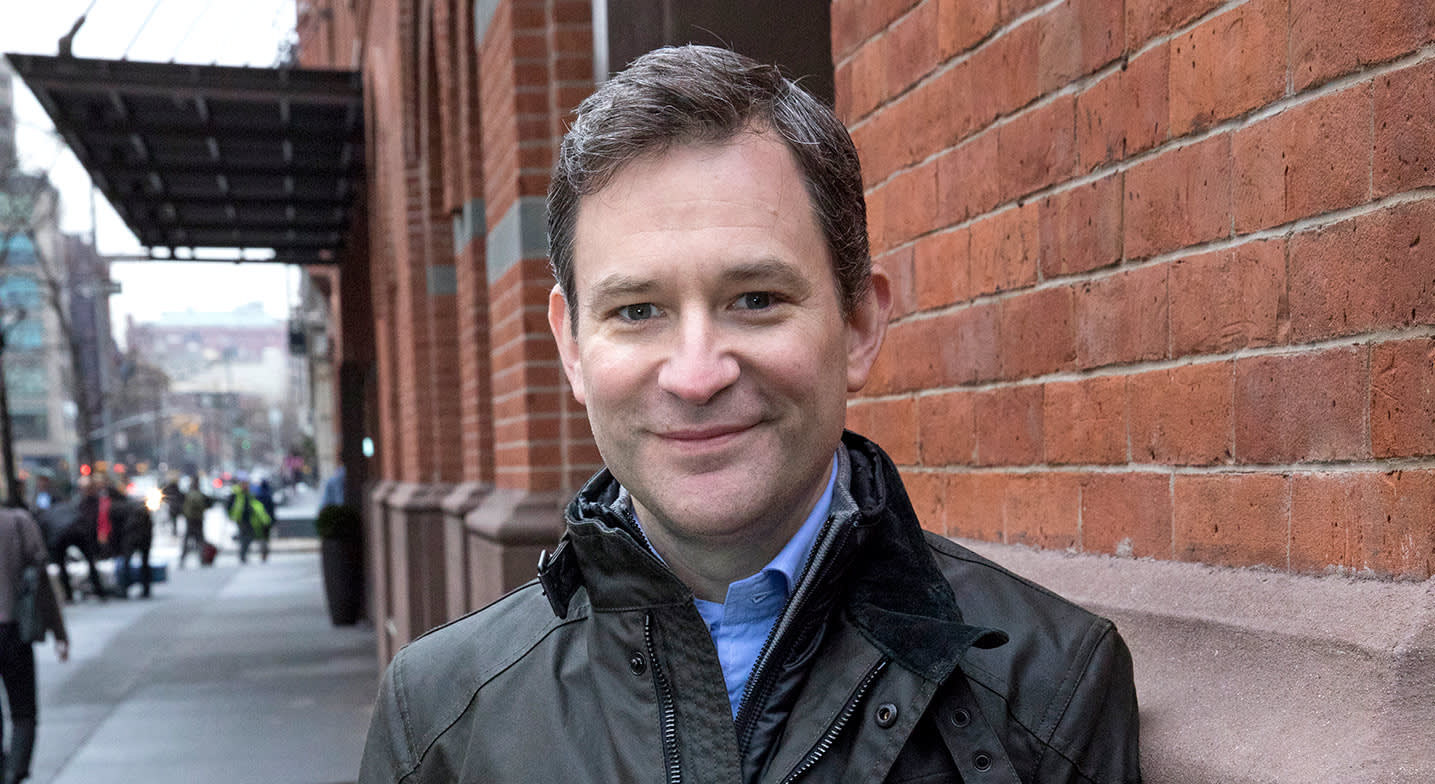Note: Text has been edited and does not match audio exactly.
Kat Johnson: Hello. I'm Audible Editor Kat Johnson, speaking today with record label founder turned meditation guru Jesse Israel, who is the founder of The Big Quiet, which creates powerful global mass meditation events both in person and virtually, and, of course, you can find them in audio too.
Jesse, it's such a pleasure to meet you. I know your voice from all the guided audio meditations that you've done with Audible, so I feel like I know you. Welcome.
Jesse Israel: Thank you, Kat. It is so great to be here. I've really been looking forward to having this conversation together.
KJ: I'm really excited to talk to you. I also feel like this is a great time because we're at this moment in the pandemic where many of us are feeling burned out. We've hit this wall of anxiety and loneliness, and it feels like those are things meditation is uniquely situated to help with, but for some reason it's so hard for humans to do. I'd love to know how you came to meditation, and then also: Was it hard for you to do, too?
JI: I got into meditation, like you mentioned, when I used to run a record label. When I was 20 I started my label from my dorm room at New York University with my sophomore roommate. We started working with a band called MGMT that took off after a couple of years. By the time I graduated from NYU, I was 23, our label was growing quite quickly, but I was experiencing pretty debilitating stress and anxiety. I was also starting to have panic attacks. It was confusing, because we had this cool, young music label that was growing, and we were working with some really exciting bands. So I felt like because I was having this type of external success, that internally I should only be happy.
And there was a lot to be grateful for. There was definitely great stuff going on in my life, but internally I was going through some of these challenges, and it didn't really make sense to me. I was burning out and didn't really understand what that looked like, but I knew that I needed to find tools to help me work through some of the anxiety and stress I was feeling. I didn't feel like it was something I could really talk about. I actually found meditation through Googling around, looking for different places where I could learn meditation in New York. This was over 10 years ago. Meditation wasn't, and wellness wasn't, as much of a trend or something that people were really prioritizing in their lives.
I started to practice on my own, and learned in a short period of time that, yes, it was challenging to do on a daily basis, but also I saw that when I prioritized it, even if it was just making five minutes every morning, it started to bring tremendous relief to what I was experiencing around stress and around anxiety, and that the more I was practicing regularly and building a habit around it, I started to find that it wasn't just allowing me to feel less blocked, less stressed, and less anxious, but I was also getting clearer about what I stood for and how I could meaningfully give myself to my work, my role, and my relationships.
It was something that became transformative for me. That's why about six years ago, I started to dedicate myself to this work, left my label, and started The Big Quiet.
KJ: That's a big risk to take. I am really interested in what you said about making meditation into a habit and how that became successful for you.
JI: Like you said earlier, Kat, practicing meditation on a regular basis can feel really challenging. Most of us are living pretty intense lives. The bar is set so high around what's expected of us to output: do more, work more, post more, share more on social media, right? There's a lot of pressure, and the information and inputs we're processing on a daily basis is at a record high. And what a lot of science and research shows is that our brains and bodies biologically are not really capable of being able to process all the information we're taking in.
When we lived in tribes—the majority of us lived in tribes just 10,000 years ago, and we did so for hundreds of thousands of years, arguably more—the amount of information we would process in an entire lifetime is equivalent to the amount of information we process in one single day in 2021. This is a lot of demand that's been placed on us. That's in part why it's important to meditate, but it's also in part why it's so tough to sit down and make time to meditate.
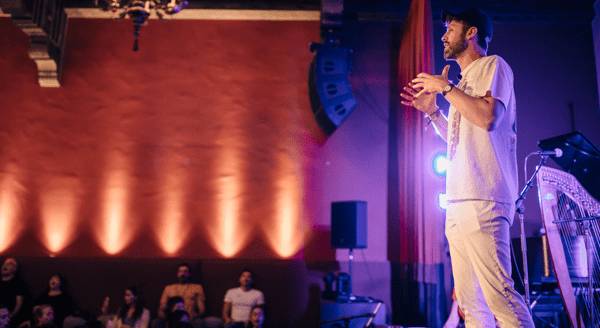
Above: Jesse leads an event at Hollywood Forever Cemetery in Los Angeles. Photograph by Lauren Kallen.
We have so much happening, and the thought of taking just a couple minutes every day can feel really daunting. I always like to start by acknowledging that I understand that this can feel tough and that this is tough, but it's totally doable regardless of how busy we are. Some of the busiest people I know—entrepreneurs, business people, actors, musicians—are making time to do this regularly, and will point to their regular practice as part of why they're experiencing such heightened creativity or a heightened sense of connection to purpose, or a greater ability to make decisions or run their business, whatever it may be.
The way I like to start is to really understand the amount of time that we meditate. Let's say we're shooting to meditate for 20 minutes once a day—that's under 2 percent of a 24-hour period. And if we're able to take that less than 2 percent of time to do that meditation, it so greatly enhances whatever else we do. It helps us sleep deeper, and it helps us live our lives more fully.
So I like to remind people that this is not something to squeeze in, but it's something that if we make the time for, greatly enhances everything else that we're doing. But when it comes to making it happen on a daily basis, I always recommend Charles Duhigg's book The Power of Habit.
KJ: Oh, yeah!
JI: This book is fascinating because when we understand how habits work, and the science behind habits, we can not only change bad habits in our lives or introduce good ones, but we also can understand how habits play a role in business, marketing, and media.
Duhigg talks about something called the habit loop. When we understand the habit loop, we're able to start to meaningfully implementing a daily, regular habit into our lives. If that habit is meditation, we can through the lens of science and a really simple process get people to introduce meditation.
KJ: I like your Instagram bio: “sharing meditation differently.” What is different about your approach, and are you seeing the demographics changing since you started in this space?
JI: Before The Big Quiet became this large-scale event, we were meeting up once a month in my buddy's apartment in downtown Manhattan, and we'd come together and meditate, and then we'd talk about the real things that were going on in our lives. The way I kind of framed these gatherings was, "Hey, we can be modern people who go out and party, who, you know, eat cheeseburgers and listen to hip-hop music, and we can also care about meditating and talking about real things that are going on in our lives, and being vulnerable, having a sense of community, and focusing on our well-being."
I love this idea that we can be both, because so much of what I saw in wellness, and still often see, is that to practice wellness, we're supposed to look and feel a certain way. A lot of times, and this is true with a lot of the branding and messaging we see in wellness, it needs to be kind of textbook spiritual-friendly. We see a lot of the fingers, and the meditation pose, and someone sitting by the beach cross-legged, and this stuff can be really beautiful and peaceful. It definitely speaks to a certain demographic, but I do know from just talking to lots of people, and even from my own experience, that that also doesn't always resonate with everybody. For a lot of people, that doesn't click for them.
What I became really interested in was, how do we make wellness feel more inclusive? How do we make meditation feel more accessible? And how can we do that by really meeting people at the level that they're at in the ways that we talk about meditation, organize our events, and brand and message our gatherings?
So someone who's never done this before can go, "Oh, here's a new way for me to start to learn about this." And do it in a way that feels relevant to their lives. Because if we're able to make wellness more inclusive and speak to more people, ultimately, the world becomes a greater place, because as more people feel better, the way that people contribute to the world around them is better.
I've always been really passionate about this. At our Big Quiet mass meditation events, we always have musical performances when people open their eyes. Instead of it being spiritual music, we'll book popular musicians. We've done Big Quiets with huge musicians like Miguel and members of Arcade Fire, and it's been really fun to blend popular culture with well-being in this way. We will host our events at places like Madison Square Garden, the top of the World Trade Center, and at some of the most incredible museums in the country, places where we think of art and culture, where we're coming together to sit in stillness, and to share in quiet and community.
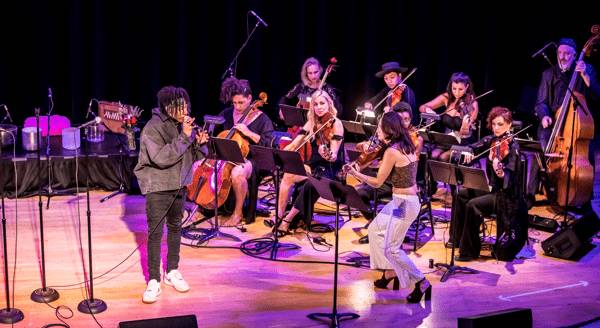
Above: On stage at a Big Quiet event at New York's Town Hall theater. Photograph by Freedom Film.
I love fusing and blending popular culture with wellness to share these things differently. As long as we're being authentic to who we are, we find that we're able to have it resonate with younger audiences or people who maybe otherwise wouldn't, and people who do click with more traditional wellness enjoy our events too. It's just about including more people.
KJ: You recently joined Oprah's 2020 Vision Tour, which was probably one of the biggest events you've done. What was it like to lead that experience?
JI: It was so powerful. Before I went on tour with Oprah, The Big Quiet was doing 3-4,000-person events max, which is pretty incredible to be meditating with that many people at some pretty incredible landmarks. When Oprah and WW invited The Big Quiet to go on tour, we were doing sold-out stadiums and arenas of people: 15,000, 17,000 people doing mass meditations every weekend for a 10-week period. It was unlike anything we'd experienced before.
To be in a place like the Barclays Center in Brooklyn, an arena that's hosted the greatest athletes and the greatest musicians, and to just be in total silence in a space that is usually used for so much excitement and energy was unlike anything I'd experienced. We were doing this thing where I was guiding the meditation for about eight minutes, and Jackie from The Big Quiet was playing sound bowls, and Oprah would go and sit in the audience, and she would actually close her eyes and sit during the meditation.
And then, for the last minute of each one of these mass meditations, we would move into total silence. The sound bowls would go off. My instruction would end, and for 60 seconds we would sit in these sold-out arenas, and there was no sound. Part of what was so powerful about it was that all it would take is one person to start yelling or laughing, or one group of people to play music and not participate. And everyone would be able to hear it, because if one person coughed, the whole arena could hear it. And what we saw was that in each one of these tour stops, people were fully in. Everyone was participating and contributing to the silence that we were creating together.
It was so silent with that many bodies, you could almost feel it. You could almost hear the silence. It was so interesting to hear the sound of 17,000 bodies sitting still together, and to do it in a way that wasn't taking a moment of silence, which is often something we do around something that's sad.
But we were doing this around connection and around joy, and the meditation was through sending love. There was just something really, really potent about it and very emotional. And one of the things that was happening on the tour was, I was guiding people to just allow themselves to feel whatever emotions were coming up for them. Giving thousands of people permission to just feel what they're feeling, to just be who they are, to not try to change it, or fix it, or push it away, or judge it. And there's something about collectively being given permission to just feel what we're feeling.
It brought up a lot of emotions. There were lots of people crying during these meditations, and there was something really beautiful to just be human together in that way as a group. At each one of these tour stops after the meditation, Oprah would come up onstage, and she and I would talk together about meditation, about how to build a regular practice into our lives, about why the experience was so emotional, and it was just so cool to be onstage with someone that I've looked up to for so long, and to be sharing this message together with so many people.
I feel very, very grateful and fortunate to have had that experience. And then, three days after the last tour stop, the pandemic and lockdown clicked in. We went from being in arenas of people on a Saturday to the following Saturday being in complete lockdown.
KJ: Wow. And then you just keep evolving, because that's what you do.
JI: That's all we can do.
KJ: When you were talking about that amazing feeling of connectedness, I've experienced that in much smaller settings of sound baths, but what I'm thinking about is my own family. We're kind of reaching the pandemic wall I talked about. My kids have been a little sad, and I was trying to explain to them, "Yes, it sucks, but it's sort of helpful to know that around the world many people are going through the same thing right now in different levels, in different ways."
But it does feel like even though we're separated and distanced, there is this collective kind of mood because of this global experience that we're having. Which brings us to the virtual mass meditations. Do you think we can virtually forge that connection? And how is it different doing those types of events?
JI: When the pandemic kicked in and we shifted from doing these really large-scale events to suddenly looking at what it would mean to do our work virtually, we had no idea if it was going to work. I had never done any virtual teaching, talks, mass meditations. All of my work was done in person up to this point. We didn't know if it was going to work, but what we saw in a very short period of time, right in the early days of the pandemic, was that having these moments, taking the space to slow down together, get intentional together, move into our hearts together, does work.
In some ways it's even more powerful, because we're able to tune in from lots of different parts of the world at the same time. The first time I got to experience it was with a big Fortune 500 company. They had asked me to guide a mass meditation with a very large group of their global sales team, and there were people tuning in from all over the world, and people were freaked out about the pandemic. It was maybe a week or two into it.
To be given the space to just get quiet together, to connect in this way—there's a love practice I bring into our meditations that gets us thinking about someone that we love and sending love to them, and then thinking about ourselves and sending love to ourselves—sharing that as a team, globally, created something really special. When we've continued to extend that experience we've seen that it can really create value for people.
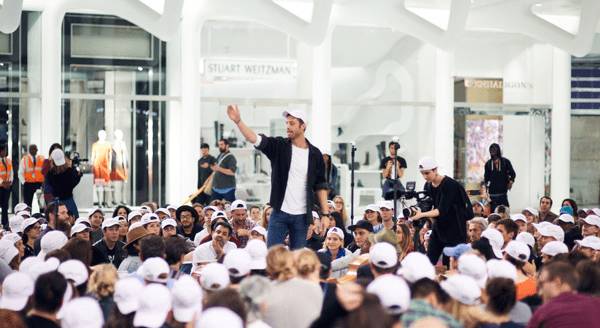
Above: A gathering of The Big Quiet at the Oculus in New York. Photograph by Felix Kunze.
We got to do that just a couple of weekends ago with Audible. We did our first virtual mass meditation open to the public, because most of these had been done through our corporate work or courses. It felt really awesome to have so many people tuning in from so many different parts of the world to share in this moment. And unlike watching a talk or seeing a performance where it's a very one-way experience, with something like this mass meditation, everyone's participating, everyone's contributing to it in real time, sitting for that moment of quiet together.
It just feels good to know that we are a part of something that other people are doing at the same time that is positive-values based, and that we're setting meaningful intentions for what's going on in our lives and the world around us. And it was really cool to see that this mass meditation that we did with Audible wound up having more than 800,000 people participate globally.
KJ: You've also been able to translate what you do so well to the audio format. I'd love to talk about how you create your guided audio meditations. Is that something you script in a different way, or do you kind of tap into the same part of yourself?
JI: I really love to as much as possible create the space to just feel into it. I'll have an outline for recording these guided audio meditations, but I like to leave space to bring some of what feels right to me in the moment to the guided meditation. Part of why I loved creating our meditations with Audible is that we were able to bring some of our favorite musicians into the studio. We're incorporating some pretty meaningful musicians while also guiding these practices: violinists, harpists, cellists, electric guitarists, sound bowl practitioners.
KJ: Yes! Can we talk about Jackie Cantwell? She's the sound bowl queen.
JI: She is the sound bowl queen. Jackie is a critical part of The Big Quiet team, and shee plays sound bowls for all the Big Quiet events. Jackie and I were doing all the Oprah tour stops together. On any track we have with Audible where there are sound bowls, Jackie was behind those bowls.
Jackie uses some of the best sound bowls in the world, and what's so powerful about these is that when we listen to them, there's a frequency that gets released. When we listen to that frequency, it helps settle the mind and the body. It helps bring the mind and the body into a more relaxed state, as does the guidance from the meditation. When we have the guidance as well as the frequency that's emitted from the bowls come together, it really helps people move into that more relaxed state to help cool off the body's fight-or-flight and bring balance to the body's nervous system. Audio is a great way to support people in regards to meditation. That's why it's felt like such a good fit doing this with Audible.
KJ: Thinking about people's levels of burnout and anxiety right now, is there anything you would recommend we do?
JI: In general what I suggest—and I know not everyone has access to nature or wants to go outside when it's really cold—is to just take a couple of moments in nature when we're able to. Without the phone, ideally, and with our feet or skin connected to the earth's surface in some way if we can, to just breathe in the air and take those moments where we get out of the regular space that we're in. Intentionally taking these little moments where you can be in nature really helps level-set the body's nervous system and bring down some of those burnout symptoms.
There are also some great meditations we've done with Audible. One that people have really clicked with is Crystal Bowl Breathing. It's a short meditation, and it's great for helping people sleep at night. Jackie plays bowls, and I introduce a simple guided meditation, a breathing technique that helps bring balance to the body's nervous system.
One of the upsides, and downsides, of being stressed all the time is the body's nervous system thinks we're being under attack, so it wants to keep us safe. When we're very stressed, it's really hard to sleep deeply because the body thinks it needs to keep us alert. Crystal Bowl Breathing introduces a simple breathing technique that turns off the body's fight-or-flight, so you can rest deeply and soundly. And of course, getting good sleep is critical to preventing burnout.
KJ: I'd love to know what you think about the future of gatherings in general. Do you think people are craving those big events again, or is it going to be tough for us to ease into them?
JI: I do think people are craving them. And I think that there will be a little bit of trauma, a little bit of discomfort being around big groups because of how ingrained it is in our systems to stay away from people. I mean, it's been so ingrained in us for a good reason, for safety reasons, so I do think there's going to be some discomfort around gathering again. But because gathering is so central to how we exist, so necessary for our survival and well-being, I believe that we're going to be able to snap back into it in a very short period of time when we're able to do so safely.
So, maybe a little bit of discomfort at the start, but I think that the joy that we're going to feel and the connection that we're craving will greatly surpass that discomfort when we can gather safely, and that we will not only get back to gathering again but there'll be a whole new level of excitement for it. When we're going to be able to safely do that, I'm not so sure, but I think that we will come back strong.
KJ: Are there any evolutions that you've made to your own practice or to The Big Quiet during the pandemic that you think might stick around?
JI: Yes. The main thing we're focusing on right now are virtual courses where I'm teaching people how to meditate, and doing it in community, in small groups where we can learn together on Zoom, where you can see each other. Once people graduate from this three-session course they have a self-sufficient practice, they can meditate on their own anytime, anywhere, and it's powerfully transformative. And then we have group check-ins through The Big Quiet where people can jump in and meditate with other humans in real time.
I provide one-to-one support for anyone who's taking this course. This has been a really interesting way for us to not just gather groups of people, but to actually give people the tools to bring meditation into their lives, and it's working. We've got a really awesome community of thousands of people who are learning and practicing meditation, and we 100 percent plan to continue this when we're able to gather in-person again. I think being able to do our large-scale events in person and virtually, and then also have virtual education and virtual community, will continue to be a really important part of The Big Quiet.
For anyone who's interested in taking this course, check out thebigquiet.com or The Big Quiet on Instagram. We're running these courses at least once a month right now, and I'm looking forward to continuing that post-pandemic as well.
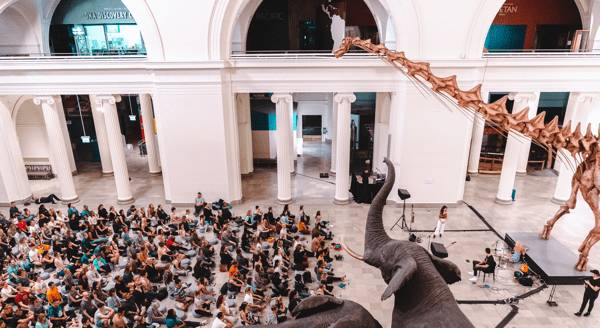
Above: An event from The Big Quiet at Field Museum of Natural History in Chicago. Photograph by Jacqui Robertson.
KJ: Thinking big, what do you think could happen if everybody meditated? What are the benefits for society at large?
JI: Fantastic question.
KJ: Because I feel like it could save us if we could only do it.
JI: I feel that way too. To ground this question in something tangible: If we look at the science behind what's happening when we practice meditation, just a few minutes of meditation turns off the body's stress response. The body's stress response is a result of the fight-or-flight, this mechanism in the body that jolts on when the body thinks it's under attack. And the fight-or-flight response is really helpful when we're actually under attack. When we were hunters and gatherers, if we were hunting for our afternoon lunch and a saber-toothed tiger jumped out on the path, a handful of physiological changes occur in the system, so we can either fight that tiger or run for it. A stress response kicks in that allows the body to do that.
Now, here we are today, in a relatively short period of time, and the world has changed drastically around us. The average person in a modern city or suburb is experiencing about 25 of these fight-or-flight triggers on any given day, but it's not saber-toothed tigers that are about to eat us; they're emails from a rude colleague, or it's a triggering social media post, or it's sitting in traffic and having cars blow their horns at us when we're not going anywhere—things that are not actually threats to our survival. Most of the stress that we're experiencing just through living a modern life is not necessary. In fact, when we're experiencing this much of it, it starts to have detrimental impact on our bodies. Ninety percent of doctor visits are the result of stress. The last thing I'll say before I answer your beautiful question is it's not only having a real impact on the body and creating a real burden on the body, but stress really affects the brain.
Our decision-making becomes poor when we're experiencing stress. The brain's prefrontal cortex, which we can think of as the brain's CEO, the decision-maker, gets shut off when we feel stressed. It's like we have these bodies operating without the CEO really leading powerfully. Our creativity gets shut down, right? Lots of things happen when we're experiencing stress.
When we start experiencing meditation and practicing meditation, all of these things change, the fight-or-flight response becomes more regulated, so it gets used for when we really need it. Otherwise, we don't have as much or none of the stress response that we did before. The body's immune system starts to operate more fluidly. We get sick less. We sleep better. The prefrontal cortex starts to wake up. It actually thickens and becomes brighter. Our ability to come from a place of empathy, to enact compassion, to be better decision makers, to think not only about ourselves, because we're in survival mode all the time, but about others and the greater good, because we're coming from a healthier, more expansive space—all these things start to shift.
If we have more humans on planet Earth with healthier immune systems, getting sick less, feeling healthier, feeling clearer, brains lit up, coming more from the heart, naturally thinking of others, naturally thinking about how we can contribute because this is how we're designed to operate, coming from tribes. We needed to contribute. We needed to be thinking about the greater good, otherwise we wouldn't exist.
We see when people practice meditation, they just start to think about the greater good, and they start to operate in a way that allows them to give, to lean more into their potential. And the more that we have people leaning into their potential, the more we're able to creatively solve for what the world needs. More creativity, more business ideas, more solutions to the world's greatest problems.
I think on a social level, if we have more people meditating, we have more people thinking about each other. We have more people pausing to consider other opinions. We have less reaction from stress and more responsiveness from creativity. From a problem-solving standpoint, we'll have way more people who are thinking about how to really solve for what the world needs right now. We would see a world with a lot less physical and mental illness, with a lot more love and support amongst each other, with a lot less division amongst groups, and with a lot of innovation around what the world needs to really thrive.
KJ: I so agree with you, because I feel like our leaders are just as stressed as the next person. So the idea of approaching things with this much alertness and empathy is such a great concept, and a very worthy cause.
JI: Thanks, Kat. No one's ever asked me that question in an interview, and I think it's so important. My belief is that we don't need every single person in the world to meditate to get those benefits. If we can get just a small percentage of the world's population practicing regularly, the ripple effect is so strong that it will greatly impact our world. There've been some really interesting studies by TM (Transcendental Meditation) around mass meditations, large groups meditating regularly. We're talking about as little as 4,000 people practicing together regularly lowering crime rates in major cities. If people want to dig deeper into these, look into the TM studies on mass meditations.
KJ: That's fascinating. Jesse Israel, thank you so much for speaking to us today. And you can find meditations from The Big Quiet on Audible at audible.com/bigquiet.
JI: Thank you so much, Kat, and thank you to the Audible team for the continued collaboration and for having me here.




